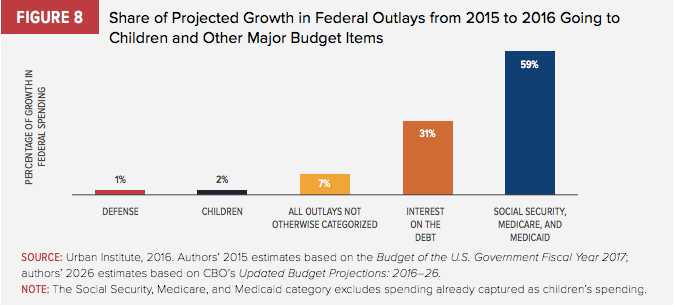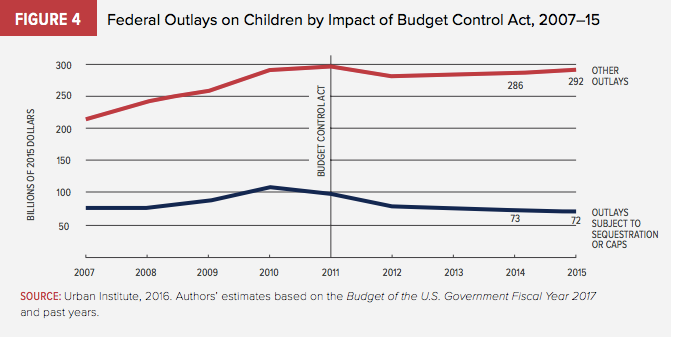In a new report by the Urban Institute entitled Kids’ Share 2016, the authors found that state and local spending on education declined dramatically during the Great Recession. Co-author Julia Issacs writes, “As the economy turned downward in late 2008, local revenues fell with the drop in property values, and state revenues fell with declines in earning and income.”
In response to the recession, safety net programs like Medicaid provided additional support to a growing number of people living in poverty, including children. However, states cut other areas of their budgets, such as education in order to balance their budgets. According to Isaacs, state and local spending on education dropped by $36 billion from 2008 to 2011 or “by more than $400 per child between 2008 and 2010.”
Fortunately, federal support for education, as part of the American Recovery and Reinvestment Act of 2009 (ARRA), increased during the period and helped compensate for the drop in state and local support for education. Isaacs adds, “Between 2008 and 2010, federal spending on education increased by more than $370 per child. As a result, total spending on education remained fairly steady at about $8,000 per child in 2008–10.”
The bad news, according to the Kids’ Share 2016 report, is that federal support for education has dropped from a high of $74 billion in 2010 to $41 billion in 2015, a decline of more than 40 percent in the last five years. The Urban Institute explains, “Some decline from the ARRA years was to be expected, but it is notable that federal education spending remains 9 percent lower than in pre-recession 2008.”
At the same time, the hope would be that state and local spending on education would have rebounded. Unfortunately, that has not happened. According to analysis by the Center on Budget and Policy Priorities, “In 30 states, total state and local funding combined fell between the 2008 and 2014 school years.”

The fact is that money matters (see here, here, here, and here) and the combined drop in federal, state, and local funding to education has been a disaster, particularly for our nation’s poorest schools.
Compounding the problem, things don’t look better over the next decade at the federal level for children. The Kids’ Share report concludes:
Under baseline projections, which assume a continuation of current law, federal expenditures on children are expected to decline, both as a share of total federal spending and as a share of the economy. Relative to other outlays and uses of our national income, children are scheduled to become an ever-declining priority.

Domestic programs that would be subjected to sequestration or discretionary caps by the Budget Control Act (BCA) of 2011 would decline. Specific to education, the Kids’ Share report estimates:
The largest projected decline is in federal funding for K-12 education. Education spending is projected to fall not only as a share of GDP (23 percent) but also in real dollars, from $41 billion in 2015 to $39 billion in 2026.
The report adds:
Over the next decade, early education and care spending is projected to decline by 24 percent as a share of GDP and $0.6 billion in real dollars.

These facts are driving members of the Children’s Budget Coalition to urge Congress to lift the BCA discretionary spending caps and to make children a greater priority in federal budget decision-making now and into the future.
In a letter to Congress on September 14, 2016, 23 members of the Children’s Budget Coalition urged Congress to support “robust funding for programs that impact children’s development and well-being, particularly in the areas of health, education, nutrition, housing, and welfare.”
This is necessary to reverse a negative downward trend in federal funding for children. According to Children’s Budget 2016, the federal share of spending on children’s programs was just 7.83 percent in 2015, and that is down from a high of 8.45 percent in 2010.


This decline will continue, according to the Urban Institute estimates, unless the next President and Congress work together to change the current trajectory.
Children can’t vote, so as the title of this Medium publication reads, we must be those “Voices4Kids” because, with a few exceptions, such as Hillary Clinton’s recent child-focused ad, attention to the issues facing children are too often ignored.
Therefore, demand that politicians explain how they will address children’s budget and policy issues. For there to be affirmative change, they must be asked to answer whether or not they will choose to invest in our nation’s children and our future. Make your voice heard in federal, state, and local elections and on ballot initiatives. Then, just like many of our nation’s pediatricians have committed to do, #VoteKids this election year.
